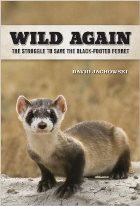Wild Again: The Struggle to Save the Black-footed Ferret
 David Jachowski
David Jachowski
University of California Press, £24.95
The other afternoon a red kite swooped across our garden and then spiralled upwards in a thermal current. Just a decade ago, this would have been unthinkable, and a decade before that, kites in Britain were vanishingly rare. In the last 20 years, they have gone from being one of the rarest of British birds to being seen regularly. Such is the promise of conservation.
In the US, a similar success story is being told. Its subject, the black-footed ferret, features in a readable new book by David Jachowski. This endearing polecat, Mustela nigripe, went one step further than the kite, for it was declared extinct in 1979. In fact, a few did survive in Wyoming and the population is now more than 1,200 with about 20 colonies living and thriving across South Dakota.
The reason for its decline was not through the usual causes – loss of habitat, predation, hunting – but because of one of the most dreaded diseases we know: plague. Yersinia pestis, which caused the Black Death, is the bacterium that almost eliminated the black-footed ferret.
David Jachowski spent 20 years as a field biologist with the US Fish and Wildlife Service, and tells his story with colloquial informality and his tales of the fleas that spread the plague bacteria (and the prairie dogs that serve as an alternative host) weave a fascinating insight.
Annoyingly, the fleas that are a principal player don't feature in the index, and the ferret is relegated to the subtitle of the book. Nonetheless, this is a good read and tells a fine story, although it does give us a worrying reminder that the plague remains much closer to home than most of us realise.


